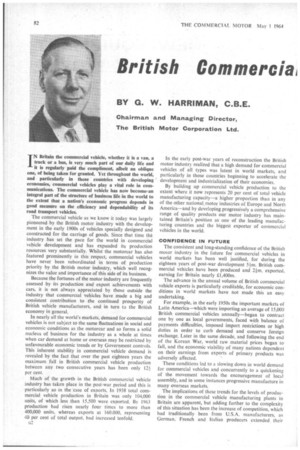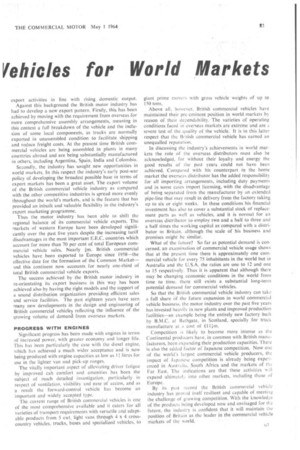British Commerciai Vehicles for World Markets
Page 84

Page 85

If you've noticed an error in this article please click here to report it so we can fix it.
BY G. W. HARRIMAN, C.B.E.
Chairman and Managing Director, The British Motor Corporation Ltd.
IN Britain the commercial vehicle, whether it is a van, a truck or a bus, is very much part of our daily life and it is regularly paid the compliment, albeit an oblique one, of being taken for granted. Yet throughout the world, and particularly in those countries with developing economies, commercial vehicles play a vital role in communications. The commercial vehicle has now becomesan integral part of the structure of business life in the world to the extent that a nation's economic progress depends in good measure on the efficiency and dependability of its road transport vehicles.
The commercial vehicle as we know it today Was largely pioneered by the British motor industry with the development in the early 1900s of vehicles specially designed and constructed for the carriage of goods. Since that time the industry has set the pace for the world in commercial vehicle development and has expanded its production resources very substantially. Whilst the motorcar has also featured prominently in this respect, commercial vehicles have never been subordinated in terms of production priority by the British motor industry, which well recognizes the value and importance of this side of its business.
Because the fortunes of the motor industry are frequently assessed by its production and export achievements with cars, it is not always appreciated by those outside the industry that commercial vehicles have made a big and consistent contribution to the continued prosperity of British vehicle manufacturers, and in turn ta the British economy in general.
In nearly all the world's markets, demand for commercial vehicles is not subject to the same fluctuations in social and economic conditions as the motorcar and so forms a solid nucleus of business for the industry as a whole at times when car demand at home or overseas may be restricted by unfavourable economic trends or by Government controls. This inherent stability in commercial vehicle demand is revealed by the fact that over the past eighteen years the maximum fall in British commercial vehicle production between any two consecutive years has been only 121 per cent. .
Much of the growth in the British commercial vehicle industry has taken place in the post-war period and this is particularly so in the 'case of exports. In 1938 total commercial vehicle production in Britain was only 104,000 units, of which less than 15,500 were exported. By 1963 production had risen nearly four times to more than 400,000 units, whereas exports at 160,000, representing 40 per cent of total output, had increased tenfold. In the early post-war years of reconstruction the British motor industry realized that a high demand for commercial vehicles of all types was latent in world markets, and particularly in those countries beginning to accelerate the development and industrialization of their economies.
By building up commercial vehicle production to the extent where it now represents 20 per cent of total vehicle manufacturing capacity—a higher proportion than in any of the other national motor industries of Europe and North America—and by developing progressively a comprehensive range of quality products our motor industry has maintained Britain's position as one of the leading manufacturing countries and the biggest exporter of commercial vehicles in the world.
CONFIDENCE IN FUTURE The consistent and long-standing confidence of the British motor industry in the future for commercial vehicles in world markets has been well justified, for during the eighteen years of post-war development 51m. British commercial vehicles have been produced and 21m. exported, earning for Britain nearly £1,400m.
The advance in the annual volume of British commercial vehicle exports is particularly creditable, for economic conditions in world markets have not made this an easy undertaking.
For example, in the early 1950s the important markets of Latin America—which were importing an average of 15,000 British commercial vehicles annually—began to contract one by one as local governments, faced with balance of payments difficulties, imposed import restrictions or high duties in order to curb demand and conserve foreign exchange, Later in the same decade, and following the end of the Korean War, world raw material prices began to fall, and the economic viability of many nations dependent on their earnings from exports of primary products was adversely affected.
These conditions led to a slowing down in world demand for commercial vehicles and concurrently to a quickening of the movement towards the encouragement of local assembly, and in some instances progressive manufacture in many overseas markets.
The implications of these trends for the levels of production in the commercial vehicle manufacturing plants in Britain are apparent, but adding further to the complexity of this situation has been the increase of competition, which had traditionally been from U.S.A. manufacturers, as German. French and Italian producers extended their
export activities in line with rising domestic output.
Against this background the British motor industry has had to develop a new export pattern. Firstly, this has been achieved by moving with the requirement from overseas for more comprehensive assembly arrangements, meaning in this context a full breakdown of the vehicle and the inclusion of son-le local components, as trucks are normally exported in unassembled condition to facilitate shipping and reduce freight costs. At the present time British cornmercial vehicles are being assembled in plants in many countries abroad and are being substantially manufactured in others, including Argentina, Spain, India and Colombia.
Secondly, the industry has sought new opportunities in world markets. In this respect the industry's early post-war policy of developing the broadest possible base in terms of export markets has been a great asset. The export volume of the British commercial vehicle industry as compared with the other competitive industries is spread more evenly throughout the world's markets, and is the feature that has provided an inbuilt and valuable flexibility in the industry's export marketing programme.
Thus the motor industry has been able to shift the regional balance of its commercial vehicle exports. The markets of western Europe have been developed sign& candy over the past five years despite the increasing tariff disadvantages in the most important E.E.C. countries which account for more than 70 per cent of total European commercial vehicle sales. Nearly im. British commercial vehicles have been exported to Europe since 1958—the effective date for the formation of the Common Market— and this continent now accounts for nearly one-third of total British commercial vehicle exports.
The success achieved by the British motor industry in re-orientating its export business in this way has been achieved also by having the right models and the support of a sound distribution organization providing efficient sales and service facilities. The past eighteen years have seen many new developments in the design and engineering of British commercial vehicles reflecting the influence of the growing volume of demana from overseas markets.
PROGRESS WITH ENGINES
Significant progress has been made with engines in terms of increased power, with greater economy and longer life: This has been particularly the case with the diesel engine, which has achieved a much wider acceptance and is now being produced with engine capacities as low as 11. litres for use in the lighter van and pick-up ranges.
The vitally important aspect of alleviating driver fatigue by improved cab comfort and amenities has been the subject of much detailed investigation, particularly in respect of ventilation, visibility and ease of access, and as a result the forward-control vehicle has become an important and widely 'accepted type,
The current range of British commercial .vehicles is one of the most comprehensive available and it caters for all varieties of transport requirements with versatile and adaptable products from 5 cwt, light vans through 4 x 4. crosscountry vehicles, trucks, buses and sPeeialized vehicles, to
giant prime movers with gross vehicle weights of up to 150 tons,
Above all, however, British commercial vehicles have maintained their pre-cmincnt position in world markets by reason of their dependability. • The varieties of operating conditions faced in overseas markets are eXtreme.and are a severe test of the quality of the vehicle." It is in this latter respect that the British commercial vehicle has earned an Unequalled reputation.
In discussing the industry's achievements in world markets the role of the overseas distributors must also be acknowledged, for without. their loyalty and energy the good results of the past years . could not have been achieved, Compared with his counterpart in the home market the overseas distributor has the added responsibility for all importing arrangements, including duty payments and in some cases import licensing, with the disadvantage of being separated from the manufacturer by an extended pipe-line that may result in delivery from the factory taking up to six or eight weeks. In these conditions his financial investment has also to cover a substantial stock of replacement parts as well as vehicles, and it is normal for an overseas distributor to employ two arid a half to three and a half times the working capital as compared with a distributor in Britain, although the scale of his business and premises might be similar,
What of the future? So far as potential demand is concerned, an examination of commercial vehicle usage shows that at the present time there is approximately one commercial vehicle for every 75 inhabitants in the world but in Australia and the U.S.A. the ratios are one to 12 and one to 15 respectively. Thus it is apparent that although there may be changing economic conditions in the world from time to time. there still exists a substantial long-term potential demand for corn mercial vehicles. •
So that the British commercial Vehicle industry can take a full share o-f the future expansion in world commercial vehicle business, the motor industry over the past five years has invested heavily in new plants and improved production facilities—an example being the entirely new factory built by B.M.C. at Bathgate, in Scotland, specially for truck manufacture at a cost of £llm.•
Competition is likely to become more intense as the Continental producers have, in common with British manufacturers, been expanding their production capacities. There is also the added factor of Japanese competition. Now one of the world's largest commercial vehicle producers, the impact of Japanese competition is already being experienced in Australia, South Africa and the markets of thi;: Far East. The indications are that these activities will expand ultimately into other markets, including those or Europe.
By its past record the British commercial vehiel: industry has proved itself resilient and capable of meeting the challenge of growing competition. With the knowledge of the products being developed now and envisaged for the future, the industry is confident that it will maintain the position of Britain as the leader in the commercial vehicle 'markets of the world.




















































































































































































































































